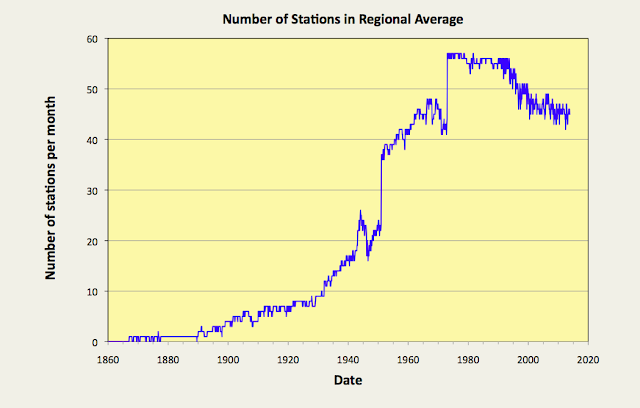In my previous post I used the temperature data from all the significant temperature records in the region to show that there is no evidence of anthropogenic global warming (AGW) in the western region of the South Pacific. Now I will demonstrate the same for the eastern region.
The eastern region I have defined to be the part of the southern Pacific Ocean between the Pitcairn Islands at a longitude of about 130.1°W and the Pacific coast of South America. This region of the ocean contains far fewer islands than the western portion, and therefore far fewer temperature records. In fact there are only seven station temperature records with more than 480 months of data, of which two are long station records with more than 1200 months. Those latter two are both located on the Chilean islands of Isla Juan Fernandez (Berkeley Earth ID: 11338 and 153937) along with one of the medium records with over 480 months of data (Berkeley Earth ID: 11341). Of the other four medium records, one is from the Pitcairn Islands (Berkeley Earth ID: 155860), one is from San Cristobal in the Galapagos Islands (Berkeley Earth ID: 154642), and two are from the Chilean island of Isla de Pascua, otherwise known as Easter Island (Berkeley Earth ID: 11362 and 153945).
Fig. 34.1: The temperature trend for the eastern South Pacific since 1900. The best fit is applied to the interval 1913-2012 and has a negative gradient of -0.10 ± 0.06 °C per century. The monthly temperature changes are defined relative to the 1951-1970 monthly averages.
The anomalies for each of the seven temperature records used were calculated by subtracting a monthly reference temperature (MRT) from each monthly reading, as described previously. These reference temperatures were calculated by averaging that month's data for the interval 1951-1970. The mean of the seven sets of anomalies is shown above in Fig. 34.1. It can clearly be seen to exhibit a negative temperature trend. In other words, there is no evidence of global warming.
Fig. 34.2: Temperature trends for all long and medium stations in the eastern South Pacific since 1900 derived by aggregating and averaging the Berkeley Earth adjusted data. The best fit linear trend line (in red) is for the period 1913-2012 and has a gradient of +0.71 ± 0.03 °C/century.
Yet the same calculation using Berkeley Earth adjusted data yields a completely different result. The warming since 1900 is now more than 0.8 °C. This is not a consequence of the data, but of the adjustments made to that data. The sum of those adjustments is illustrated below in Fig. 34.3, and indicates that they amount to a correction to the raw data of at least 0.8 °C since 1900, and possibly even more. The data in Fig. 34.3 also indicates that the vast majority of these adjustments are due to the breakpoint adjustment process rather than homogenization.
Fig. 34.3: The contribution of Berkeley Earth (BE) adjustments to the anomaly data after smoothing with a 12-month moving average. The linear best fit to the data is for the period 1913-2012 (red line) and the gradient is +0.81 ± 0.04 °C per century. The orange curve represents the contribution made to the BE adjustment curve by breakpoint adjustments only.
Conclusions
1) The overall temperature trend in the eastern region of the South Pacific over the last 100 years has been negative (see Fig. 34.1). There is no evidence in the raw temperature records of anthropogenic global warming (AGW) in this region.
2) In contrast, the adjusted temperature data constructed by Berkeley Earth exhibits a strong warming trend in its aggregated data of over 0.7 °C per century since 1900 (see Fig. 34.2).
3) The adjustments made to the raw temperature data by Berkeley Earth equate to a change in the overall temperature trend of more than 0.8 °C per century. Almost all of this is the result of adjustments made using the breakpoint adjustment process (see Fig 34.3).
Addendum
The data in Fig. 34.1 above was calculated by averaging the records of the seven stations listed. However, as three of those stations are in close proximity to each other on Isla Juan Fernandez, and another two are likewise in close proximity on Isla de Pascua, it could be argued that relative weightings of 1/3 and 1/2 respectively should be applied to these stations. It so, then the overall temperature trend will change to that shown below in Fig. 34.4. The principal result here is that the new temperature trend with the station weightings is now even more negative: -0.18 ± 0.07 °C per century.
Fig. 34.4: The temperature trend for the eastern South Pacific since 1900. The best fit is applied to the interval 1913-2012 and has a negative gradient of -0.18 ± 0.07 °C per century. The monthly temperature changes are defined relative to the 1951-1970 monthly averages and local weightings are applied to the different temperature anomalies.
































